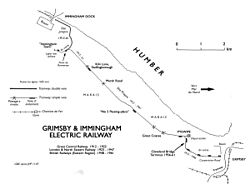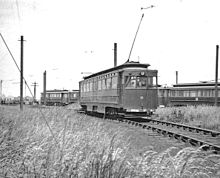In the 1940's and 50's there weren't many cars on the roads of Cleethorpes and Grimsby. Kids could play in the side streets without the fear of being run over and it was generally much quieter.
Trams operated from Grimsby to Immingham along the coast of the
Humber Estuary. They ran from 1921 to (surprisingly for me) 1961! Now I don't remember travelling on them for general day to day purposes but I can remember my mam taking me on a "pleasure ride" from Grimsby, along the Humber bank to Immingham and then back on the return service. From memory we got on near Corporation Bridge in Grimsby but I don't have any memory of the Immingham end. I
can remember the trip along the sea bank close to the River Humber, it seemed really close to the tracks.
 |
| The route of the Grimsby & Immingham Electric Railway. |
 |
| A Grimsby/Immingham tram, built in 1915 passing the Pywipe depot outbound for Immingham. |
The trams were standard gauge and ran for 7 miles between Grimsby & Immingham which was a developing seaport needing lots of contract workers so the tram system was well used.
The headquarters for the trams was in Victoria Street, Grimsby and that was where the tramsheds were. They are still there to this day having been utilised as the towns' bus depot and workshops when busses replaced the trams.
Trolley busses also operated in Grimsby and Cleethorpes while the
trams were still in use and ran from Corporation Road, Grimsby to The Bathing Pool at the South end of Cleethorpes. Trolley busses were powered by overhead wires as trams were but whereas trams ran on rails a trolleybus ran on pneumatic tyres along the roads.
Trolley busses ran in from the 3rd of October 1936 until the 4th of June 1960. They were replaced with petrol engined busses, noisier and smellier than the electric trolley busses and nowhere as pleasant to travel on.
 |
| A trolley bus operating in Cleethorpes, the overhead wires can be seen, they were suspended on steel poles. |
Trolley busses ran in from the 3rd of October 1936 until the 4th of June 1960. They were replaced with petrol engined busses, noisier and smellier than the electric trolley busses and nowhere as pleasant to travel on.



No comments:
Post a Comment